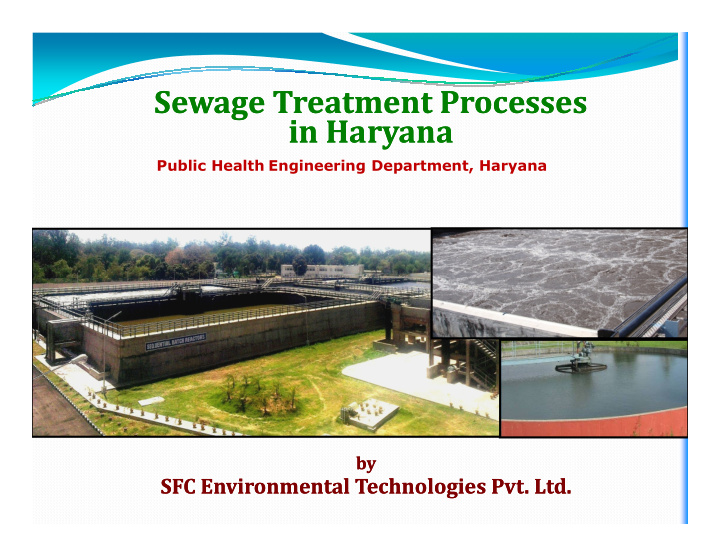



Sewage Treatment Processes Sewage Treatment Processes in Haryana in Haryana ������������� ������������������������������� by by SFC Environmental Technologies SFC Environmental Technologies Pvt. Pvt. Ltd. Ltd.
Contents • Introduction • Sewage Characterisation • Treated Sewage Discharge Standards • • Treatment units in Sewage Treatment Treatment units in Sewage Treatment • Basics of Biological Process • Overview of Sewage Treatment Technologies • Technology Pros and Cons • Discussion
Introduction
POPULATION TOTAL POPULATION AS PER 2011 CENSUS 121,01,93,422 URBAN URBAN RURAL
URBAN POPULATION Urban Population in crores 120 100 80 60 40 20 0 2011 2021 2031 2041 2051 Year
SEWAGE GENERATION Estimated sewage generation, MLD 120000 100000 80000 60000 60000 40000 GAP 20000 STP Capacity as on 2009 - 11553 0 2011 2021 2031 2041 2051 Year
Status of Most Sewage Treatment Plant in India
Sewage generation & Treatment Sewage generation & Treatment Ref Ref : : CPCB CPCB Report Report on on Performance Performance Evaluation Evaluation of of STPs, STPs, 2013 2013
Over Exploiting & Indiscriminate Disposal Of Polluted Water Into Limited Water Resources Is Further Aggravating The Problem
Sewage discharge into river
State of Yamuna river
Polluted Yamuna
Dal Lake, Srinagar
Powai Lake, Mumbai
Usual scenes of water bodies
Haryana Scenario 2001 2011 2021 Urban Population 2,964,678 4,755,000 10,504,000 Sewage generation, MLD 374 599 1342 Sewage Treated, MLD 164 199 Gap, MLD 200 400 Ref : National Capital Region Planning Board (NCRPB) Report, Ministry of Urban Development, GoI 400 MLD sewage goes untreated into water bodies / drains / rivers
About SETPL.... Proper & efficient treatment technology is required for providing Sustainable & Economical Solution to this problem …
Sewage Characteristics
Types of contaminants in Sewage Types of contaminants in Sewage INORGANIC ORGANIC - Decays Dissolved Dissolved Suspended Suspended • Vegetable matter • Salt • Floating • Sugar � Plastic bags • Food residue • Milk • Settling � Sand � Grit Primary No Biological treatment treatment treatment
SEWAGE CHARACTERISTICS RAW SEWAGE CONTAINS Chokes pumps/ pipes Floating material/ Large suspended matter Silting in tanks/ receiving bodies Sand/ Grit Floating scum/ sticking to tanks Floating scum/ sticking to tanks Oil & Grease Oil & Grease & pipes Silting & septicity Suspended Solids Septicity/ odour/ depletion of DO Organic matter (BOD/COD) Growth of aquatic plants Nitrogen Growth of aquatic plants Phosporous
BOD / COD BOD / COD COD BOD Chemical Oxygen Demand Biological Oxygen Demand Dissolved Dissolved Suspended Suspended • Vegetable matter • Sulphides • Chemicals • Sugar • Food residue • Oil • Milk BOD is amount of oxygen COD is amount of oxygen required by bacteria to degrade required by chemicals to organic matter degrade organic matter
TREATMENT STANDARDS MoUD State PCB US EPA Parameter Raw CPCB < 30 < 10 < 10 BOD5, mg/L 250-300 < 30 -- COD, mg/L 400-550 < 250 < 250 -- < 10 < 100 -- TSS, mg/L 300-600 < 100 -- -- < 2 Turbidity, NTU -- -- -- -- < 50 < 50 -- -- NH4-N, mg/L NH4-N, mg/L 35-45 35-45 < 50 < 50 -- < 10 -- TN, mg/L 40-50 -- < 2 TP, mg/L 5-8 < 5 < 5 -- -- 5.5 to 9.0 6-9 pH 5.5 to 8.5 5.5 to 9.0 < 230 10 6 -- Nil Faecal -- Coliforms (MPN/100 ml) -- < 1 < 1 Residual < 1 -- Chlorine, mg/L
Sewage Flows
DAILY FLOW VARIATIONS OF RAW SEWAGE 250 Peak Flow – 2.25 times 200 Peak Flow % Design Flow 150 Average Flow 100 50 Lean Flow – 0.5 times 0 1 2 3 4 5 6 7 8 9 10 11 12 13 14 15 16 17 18 19 20 21 22 23 24 25 Hrs Pumps have to be designed to cater to both peak and average flow.
Typical Flow Diagram of Sewage Treatment Plant Typical Flow Diagram of Sewage Treatment Plant FINE RAW SCREENING GRIT COARSE SEWAGE INLET CHAMBER GRIT REMOVAL SCREENING RAW SEWAGE PUMPING PRIMARY TREATMENT PRIMARY TREATMENT RAW SEWAGE PUMPING STATION RAW SEWAGE PUMPING STATION CHLORINE TREATED WATER SLUDGE DISINFECTION RECIRCULATION AERATION TANK TERTIARY TREATMENT AIR BLOWER SECONDARY CLARIFIER SECONDARY TREATMENT SLUDGE CENTRATE TO AT SLUDGE DEWATERING SURPLUS SLUDGE SLUDGE CENTRIFUGE SUMP
Basics of Biological Treatment
BASICS OF AEROBIC BIOLOGICAL PROCESS ORGANIC MATTER + BACTERIA + OXYGEN � ORGANIC MATTER + BACTERIA + OXYGEN � � � � � � � BOD/COD MLSS NEW BACTERIA + CO2 + H2O SURPLUS SLUDGE
CO 2 , H 2 0 NEW NEW CELLS (SLUDGE) ORGANIC MATTER
TO MEET THE OBJECTIVE OF ORGANIC MATTER REMOVAL, BIO-MASS FORMED (WHICH ITSELF IS ORGANIC IN NATURE) SHOULD ALSO BE SEPARATED.
USUALLY, A SETTLING TANK IS PROVIDED TO SEPARATE BIO-MASS FORMED DURING ORGANIC MATTER DEGRADATION.
ORGANIC NUTRIENTS MATTER O2 (FOOD) (N/P) BACTERIA TEMP. MIXING AERATION BASIN
Next Session : Next Session : Next Session : Next Session : Sewage Treatment Units & Sewage Treatment Units & Sewage Treatment Units & Sewage Treatment Units & Biological Treatment Technologies Biological Treatment Technologies Biological Treatment Technologies Biological Treatment Technologies ����������� ����������� ����������� ����������� ����������� ����������� ����������� �����������
Recommend
More recommend